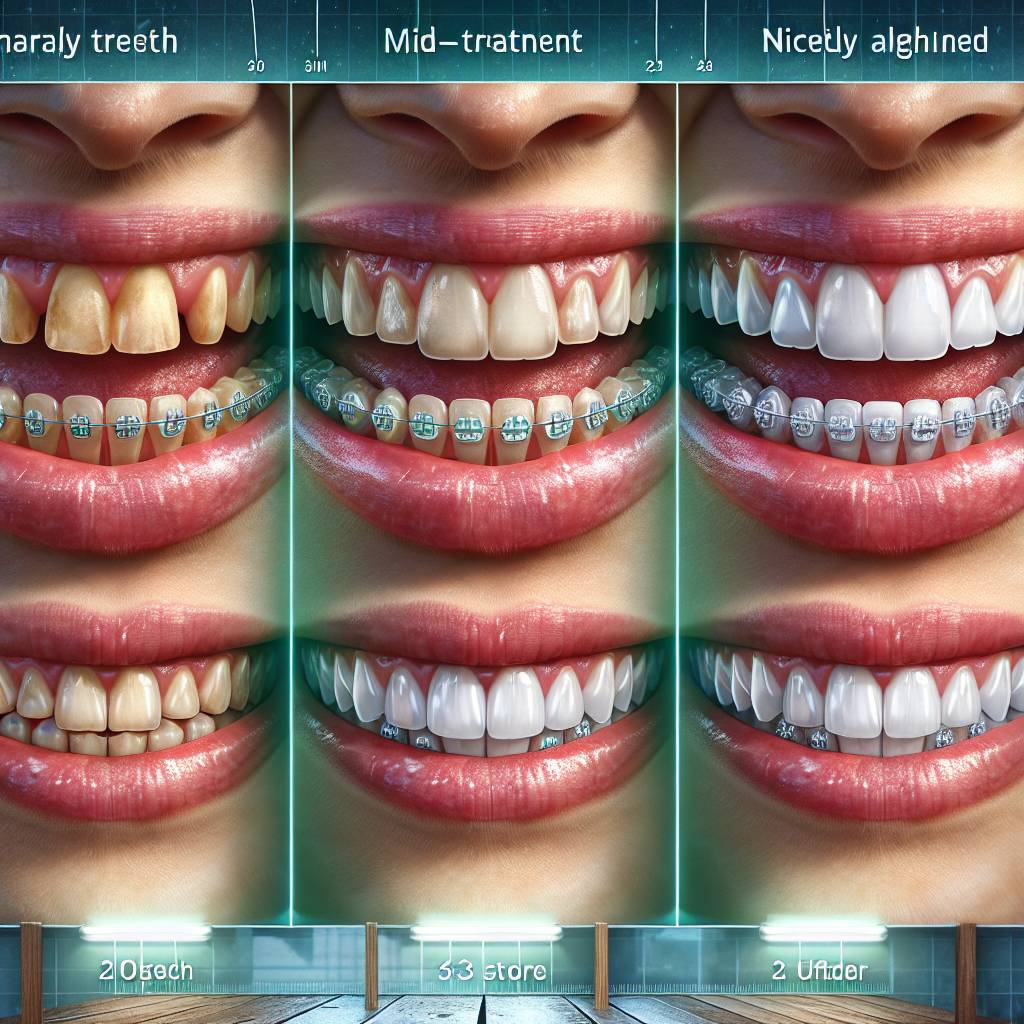Invisalign is an effective orthodontic treatment that can help straighten your teeth without the need for traditional metal braces. But how long does it take for Invisalign to straighten your teeth? The answer depends on several factors, including the severity of your misalignment and how quickly you wear your aligners. In general, it can take anywhere from six months to two years for Invisalign to achieve the desired results.The amount of time it takes for Invisalign to straighten teeth will depend on the severity of the misalignment and each patient’s individual treatment plan. On average, most Invisalign treatments take 9-15 months to complete.
Invisalign Treatment Time
Invisalign treatment time can vary depending on the individual patient’s goals and the complexity of their case. Generally, Invisalign treatment times are shorter than traditional braces, but the exact amount of time it takes to complete treatment will depend on the patient’s orthodontic needs. On average, patients usually finish their treatment within 12 months. However, some cases may require more time and can take up to two years to complete.
The complexity of a case is an important factor in determining how long it will take to finish Invisalign treatment. Patients with more complicated cases may need more time for their teeth to move into position. Additionally, how quickly a patient follows their doctor’s instructions and wears their aligners for 20-22 hours every day can also influence treatment times.
Overall, Invisalign treatment times are typically shorter than traditional braces due to the advanced technology used by Invisalign. However, each individual case is unique and may require different amounts of time for successful completion. It is important that patients listen to their doctor’s instructions in order to ensure that they get the best results from their Invisalign treatment.
What Factors Determine Invisalign Treatment Length?
The length of time it takes to complete Invisalign treatment depends on a variety of factors, including the severity of the alignment issue, the complexity of the bite correction, and the patient’s dedication to wear their aligners as prescribed. Generally speaking, Invisalign treatment can take anywhere from 6 months to 2 years.
Patients with mild-to-moderate alignment issues can typically expect their treatment to take about 12 months. For more severe cases that require complex bite corrections, 18-24 months is a more realistic timeline.
In addition to the complexity of your orthodontic case, your compliance with wearing your aligners for 20-22 hours a day will also have a significant impact on how quickly you reach your desired outcomes. The average patient wears their aligners for about 15 hours per day; if you’re dedicated to wearing your aligners for at least 20 hours per day, you may be able to finish your Invisalign treatment before your estimated timeline.
Your orthodontist will be able to provide you with an accurate estimate of how long your Invisalign treatment will take based on all of these factors. Once you start treatment, they’ll be able to track your progress throughout and make any necessary adjustments that may help speed up or slow down your progress as needed.
Is Invisalign Faster Than Traditional Braces?
Invisalign is a modern and discreet alternative to traditional braces for straightening teeth. It uses a series of custom-made, nearly invisible aligners to gradually move your teeth into place. But does it work faster than traditional braces?
The answer is yes, in most cases, Invisalign is faster than traditional braces. The length of treatment depends on the severity of the misalignment and how closely you follow your treatment plan. Generally speaking, people with mild to moderate alignment issues tend to see results in about 12 months with Invisalign, while traditional braces may take up to two years or more.
One of the main reasons Invisalign works faster is because the aligners are designed specifically for your mouth. Because they fit snugly against your teeth and don’t require any additional hardware like brackets or wires, they are able to apply consistent pressure from all angles to shift your teeth into position more quickly and efficiently than metal brackets and wires.
In addition, you can switch out your aligners every two weeks as opposed to waiting for office visits with braces, which means that progress can be made between adjustments rather than just at appointments. With regular wear and timely replacements, you can expect to see results in a shorter period of time compared to traditional braces.
Overall, Invisalign may be a slightly more expensive option than traditional braces but it tends to offer faster results due its customized design and convenient replacement schedule. However, it’s important to remember that every case is different so it’s best to consult with an orthodontist who can provide an accurate treatment timeline based on your specific needs.
Speeding Up Your Invisalign Treatment Time
Invisalign is one of the most popular orthodontic treatments available, and it can work wonders for straightening your teeth. However, the treatment can take some time to complete, and some patients may be anxious to get their smile looking perfect as quickly as possible. Fortunately, there are a few ways to speed up your Invisalign treatment time.
One of the best ways to speed up your Invisalign treatment is to follow all of your dentist’s instructions closely. Your dentist will provide you with a plan for wearing Invisalign aligners and may recommend that you wear them for at least 20-22 hours per day. Wearing them less than this may slow down the progress of your treatment. Make sure you also keep your appointments with your dentist so they can check on the progress of your treatment and make any necessary adjustments.
You should also practice good oral hygiene while wearing Invisalign aligners. This means brushing and flossing after every meal or snack, as well as rinsing out your aligners regularly with lukewarm water or an approved cleaning solution. Keeping your teeth clean will help reduce plaque build-up and ensure that the aligners fit properly over your teeth, which will speed up the process of straightening them.
Finally, consider investing in accelerated orthodontic treatments such as Propel or AcceleDent, which use technology to gently stimulate the bone surrounding each tooth and accelerate tooth movement. These treatments are a great way to cut down on treatment time and can reduce it by up to 50%.
If you’re looking for ways to speed up your Invisalign treatment time, make sure you follow all of your dentist’s instructions closely, practice good oral hygiene habits while wearing aligners, and consider investing in accelerated orthodontic treatments such as Propel or AcceleDent. With these tips, you’ll be able to enjoy a perfectly straight smile that much sooner!

Initial Consultation
The initial consultation with an Invisalign dentist is an important part of the treatment process. During this session, the dentist will discuss your treatment goals and assess your teeth and jaw alignment. They will also take impressions of your teeth and create a digital model of them, which will be used to plan out your Invisalign treatment. The dentist may also recommend other treatments, such as bonding or crowns, if necessary. After the initial consult, you will be given a comprehensive treatment plan with information on what to expect during each stage of the Invisalign process.
Fabrication of Aligners
Once the initial consult is complete, the Invisalign lab will use the digital scans to fabricate a set of customized aligners for you based on your unique dental profile. The number of aligners needed can vary from person to person, depending on the severity of their misalignment and other factors. Generally speaking, it can take anywhere from 10-30 aligners for a typical case. These aligners are made from clear plastic and are designed to fit snugly around your teeth.
Wearing Aligners
Once you receive your set of aligners from the Invisalign lab, you will begin wearing them according to a prescribed schedule. Each set should be worn for at least 22 hours a day for two weeks before being replaced by the next one in sequence. As you move through each aligner in sequence, your teeth will gradually shift into the desired alignment until they reach their final position in the mouth. It’s important to note that it’s normal to experience some discomfort when wearing new aligners as they are adjusting your teeth into place.
Monitoring Progress
Your Invisalign dentist or orthodontist will monitor your progress throughout treatment with regular checkups every few months or so. During these appointments they will assess how well the treatment is working and make any necessary adjustments or provide feedback on how you can improve your results if needed. Additionally, they may also provide additional tools such as retainers or night guards if necessary after treatment is complete in order to maintain good oral health and prevent future problems from occurring.
Initial Consultation
The first step of the Invisalign process is the initial consultation. During this appointment, your orthodontist will assess your oral health and determine if Invisalign is right for you. If it is, then they will take impressions of your teeth and create a digital 3D model of your mouth. This model will be used to create a customized treatment plan, which includes the number of aligners needed and how long you’ll need to wear them.
Fabrication of Aligners
Once the treatment plan is finalized, it’s time for Invisalign to create your clear aligners. The impressions taken during your initial consultation are sent to Invisalign so that they can manufacture the aligners specifically for you. During this stage, you may have X-rays or other imaging taken in order to ensure that your treatment plan is accurate.
Wearing Aligners
Once you receive your aligners, it’s time to start wearing them! You should wear each set of aligners for at least 22 hours per day in order to achieve the best results. It’s important not to skip any day, as this could prolong treatment time and even lead to relapse of any corrections made by the aligners. You should also attend regular check-up appointments with your orthodontist throughout the course of treatment in order to monitor progress and make sure that everything is going according to plan.
Retention
Once you’ve completed the Invisalign process, it’s important that you wear a retainer in order to keep your teeth in their new positions. Your orthodontist may recommend a removable retainer or one that fits snugly around all of your teeth like a traditional wire retainer would. Retainers should be worn as directed by your orthodontist in order ensure that all corrections made with Invisalign remain in place for years into the future!
Average Completion Times for Different Patients
The average completion time for different patients can vary greatly depending on the type of treatment they are undergoing. For example, a patient receiving chemotherapy treatments may take longer to complete the course of treatment than a patient receiving surgery. In addition, the amount of time needed to complete a treatment may be affected by the patient’s age, overall health, and other factors.
In general, most treatments can be completed in two to three weeks, although this time frame may vary depending on the type of treatment and the individual patient’s circumstances. For instance, medical procedures such as cataract removal or corneal transplants can take anywhere from four to eight weeks to complete. Patients undergoing radiation therapy may also need up to four weeks or more to finish their treatment.
In some cases, such as with certain types of cancer or serious infections, more than one course of treatment may be necessary before a patient is considered cured or in remission. In these cases, total completion time can range from several months up to several years depending on the complexity of the disease and how well it responds to treatment.
Overall, it is important for patients and their families to understand that completion times will vary based on individual circumstances and should be discussed with their healthcare provider in order to make sure they are getting the best possible care for their condition.

Conclusion
Invisalign is an effective way to straighten your teeth without the need for metal braces. It can take anywhere from 6 to 18 months to complete treatment, depending on the severity of your case and how closely you follow your orthodontist’s instructions. The average time frame, however, is about 12 months. Invisalign is a great option for those who want to achieve a beautiful smile without having to wear traditional metal braces. With regular visits to your orthodontist and diligent care of your aligners, you should see great results in no time!
Overall, Invisalign is a convenient and comfortable way to get straighter teeth. It takes time and dedication but with the help of your orthodontist, you can have the smile of your dreams in no time!

